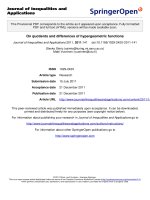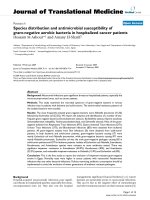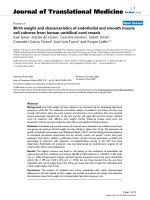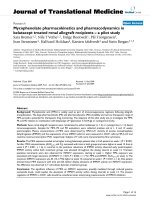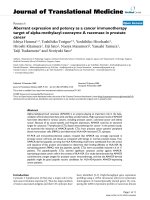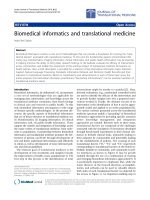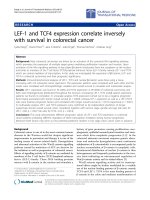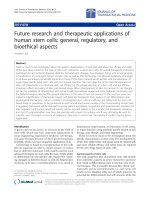Báo cáo hóa học: " Updated survivals and prognostic factor analysis in myeloma treated by a staged approach use of bortezomib/thalidomide/dexamethasone in transplant eligible patients" pot
Bạn đang xem bản rút gọn của tài liệu. Xem và tải ngay bản đầy đủ của tài liệu tại đây (477.97 KB, 7 trang )
RESEARC H Open Access
Updated survivals and prognostic factor analysis
in myeloma treated by a staged approach use of
bortezomib/thalidomide/dexamethasone in
transplant eligible patients
Chor Sang Chim
Abstract
Background: Bortezomib, an NFkB inhibitor, is an active agent for the treatment of myeloma (MM). We have
reported a promising complete remission (CR) rate for newly diagnosed myeloma patients treated by a staged
approach, in which chemosensitive patients underwent autologous haematopoietic stem cell transplantation (auto-
HSCT) while less chemosensitive patients received salvage therapy with bortezomib/thalidomide/dexamethasone
prior to auto-HSCT.
Methods: Herein, with an additional 13 months of follow-up, we reported the updated survivals, and examined
potential prognostic factors impacting event-free (EFS) and overall survival (OS).
Results: With a median follow-up of 30 months, the projected OS was 73% and EFS was 50.2%. Age, gender,
clinical stage and DAPK methylation could not account for the differential chemosensitivity. Advanced ISS stage
and DAPK methylation adversely impacted OS whereas oligoclonal reconstitution predicted superior EFS.
Conclusions: Our staged approach illustrated an economical use of expensive targeted agents while preserving a
good CR rate and OS. The comparable survivals of chemosensitive and less chemosensitive patients suggested the
staged approach might have abolished the adverse prognostic impact of suboptimal chemosensitivity. Finally, the
adverse impact of DAPK methylation and favorable impact of oligoclonal reconstitution in myeloma warrants
further study.
Background
Bortezomib, an NFkB inhibitor, is an active agent for the
treatment of myeloma (MM). After the demonstration
of its e fficacy as salvage therapy in chemo-resistant or
refractory myeloma patients with a CR rate of 9% [1,2].
a high CR rate has also been demonstrated when borte-
zomib was used in induction therapy in newly diagnosed
myeloma patients. For instance, a CR rate of 43 % and
30% was observed when bortezomib -based induction
therapy was applied in both transplant-eligible and
transplant-ineligible myeloma patients [3,4].
In Hong Kong, we have adopted a staged approach, i n
which newly diagnosed, transplant-eligible myeloma
patients were risk-stratified according to their initial che-
mosensitivity, wherein VAD-chemosensitive patients
underwent autologous hematopoietic stem ce ll tra nsplanta-
tion (auto-HSCT) while less VAD-chemosensitive patients
received salvage therapy of bortezomib/thalidomide/dexa-
methasone (VTD) before auto-HSCT.
5
(Figure1)Wehave
reported frequent occurrence of oligoclonal reconstitution,
frequent central nervous system myeloma (one with lepto-
meningeal myeloma presenting with diplopia, and the
other with intraspinal plas macytoma causing spina l cord
compression) and absence of thalidomide-related deep-
vein thrombosis despite no prophylaxis with either aspirin,
low molecular weight heparin or warfarin [5]. In addition,
at a median f ollow-up time of 17 months, w e h ave r eported
an overall CR rate of 48% (by an intention-to-treat analy-
sis), and a 3-year OS and 75% [5]. Based on this approach,
Correspondence:
Department of Medicine, Queen Mary Hospital, University of Hong Kong,
Hong Kong
Chim Journal of Translational Medicine 2010, 8:124
/>© 2010 Chim; licensee BioMed Central Ltd. This is an Open Access article distributed under the terms of the Creative Commons
Attribution License ( which permits unrestricted use, distribution, and reproduction in
any medium, provided the original work is properly cited.
only 56% myeloma patients required salvage therapy with
VTD. Herein, with an extended follow-up (median: 30
months, range: 7-54 months), w e reported t he updated s ur-
vivals. In particular, we examined if diagnosti c clinic al
parameters might account for the differential VAD chemo-
sensitivity. Moreover, potential risk factors for EFS and OS,
including methylation of Death-associated Protein Kinase
(DAPK) and the development of oligoclonal reconstitution,
were analysed.
Methods
Treatment
The study started in early 2005 and e nded in late 2008.
The medi an follow-up time was 30 months (range: 7 - 54
months). Details of the trial has been reported [5]. In brief,
25 newly diagnosed, symptomatic MM with younger than
65 years with measurable disease were enrolled. All
patients received initial cytoreduction with three cycles of
VAD (vincristine, adriamycin and dexamethasone). Those
achieving ≥ 75% reduction in paraprotein, i.e. VAD-che-
mosensitive patients, proceeded to auto-HSCT. Patients
with <75% reduction in paraprotein, i.e. less chemosensi-
tive subgroup, received salvage therapy with four cycles of
VTD (bortezomib: 1.3 mg/m
2
/day intravenously on days 1,
4, 8 and 11; thalidomide: 200 mg/day; dexamethasone:
40 mg/d orally from days 1-4 and days 8-11). After VAD
induction therapy, fourteen (56%) patients required VTD
salvage therapy. Auto-HSCT conditioning regimen com-
prised intravenous melphalan at 200 mg/m
2
. All patients
received thalidomide (100-200 mg/day) as maintenance
therapy regardless of whether VTD had been used. The
protocol was approv ed by the institution review board in
accordance with the Declaration of Helsinki, and informed
consent was obtained from all participating patients. The
treatment algorithm was shown in Figure 1.
Monitoring of response
All patients were analyzed on an intention-to-treat basis.
Progression was defined as ≥25% paraprotein increas e in
two consecutive tests four w eeks apart. R elapse was
defined as reappearance of the paraprotein on immuno-
fixation in CR patients, positive SPE in the nCR patients,
and/or appearance of new bone lesions. Oligoclonal
reconstitution, defined as the appearance of a new para-
protein persisting for ≥ 4 weeks, was demonstrated in six
patients [5]. Three patients with light chain myeloma
developed a IgG paraprotein (two IgG/kappa from free
kappa, one IgG/lambda from free lambda). One devel-
oped a double IgG/kappa from a single IgG/kappa, and
two patients had complete change of parapro tein (one
from IgA/kappa to IgG kappa, and one from IgD/lambda
to IgG/kappa).
Statistical analysis
OS was defined as time from commencement of induction
therapy to de ath or last follow-up. Event-free survival
(EFS) was defined as time from commencement of induc-
tion therapy to the date of progression, relapse or death.
Survival curves were plotted by K aplan-Meier method.
Prognostic factors including age, gender, international sta-
ging system (ISS) [6]. DAPK methylation status and
achievement of CR after auto-HSCT were studied for their
impact on survival by univariate analysi s. Survival curves
were plot ted by Kaplan-Meier method and compared by
the log-rank test [7]. Moreover, to see if early PR after one
cycle of VAD might predict subsequent need of VTD
VTD
Salvage
(n=14)
Autologous
HSCT
(n=21)
VAD
(n=25)
RESPONSE
t
75%
(n=11)
Chemo-
sensitive
Low-Risk
Less
chemo-sensitive
<75%
(n=14)
High-Risk
Figure 1 Treatment algorithm of the staged approach for newly diagnosed, symptomatic myeloma patients.
Chim Journal of Translational Medicine 2010, 8:124
/>Page 2 of 7
salvage therapy, achievement of PR, i.e >50% reduction in
paraprotein, after one cyc le of VAD was corre lated with
subsequent need of VTD salvage upon completion of
three cycles of VAD by Chi-Square test.
Methylation study
Methylation-specific polymerase chain reaction (MSP)
for aberrant promoter methylation was performed as pre-
viously described [8-10]. Treatment of DNA with bisul-
phite f or conversion of unmethylated cytosine to uracil
(but unaffecting methylated cytosine) was performed
with a commercially available kit (CpGenome DNA mod-
ification kit, Intergen, New York). The primers for the
methylated (M-MSP) and unmethylated (U-MSP) pro-
moters of DAPK has been previously described [10-12].
Results
The projected 4-year OS was 73.7%, the 4-year EFS
was 50.2% with a median follow-up time of 30 months.
(Figure 2)
Comparing the VAD-chemosensitive with the less
chemosensitive subgroups, there was no significant dif-
ference in the median age and distribution of gender,
paraprotein subtypes and International Stage. (Table 1)
Of the 22 patients with methylation study data, four
(18.2%) carried DAPK methylation. However, the pro-
portion of patients carrying DAPK methylation or devel-
oping oligoclonal reconstitution was not different. On
the other hand, more chemosensitive patients (90.9%)
achieved ≥VGPR after auto-HSCT than those less che-
mosensitive patients (p = 0.03). The projected EFS were
51.1% for chemosensitive, and 49.2% for less chemosen-
sitive patients (p = 0.974)(Table 2). The projected OS
was 71.6% and 7 6.0% for chemosensitive and less che-
mosensitive patients (p = 0.887) (Figure 3) (Table 2).
Of the 23 patients with response data a fter one cycle
of VAD, 11 (48.8%) fail to achieve PR. Of these, 1 0
(90.9%) finally required VTD salvage therapy as the cul-
mulative response after three cycles of VAD was <75%
paraprotein reduction. (p < 0.001)
Analysis of risk factors for survivals showed that only
advanced ISS (0.034) (Figure 4) and DAPK methylation
(p = 0.02) (F igure 5) predicted inferior OS but not EFS.
A
B
Figure 2 (A) Updated Overall survival (OS) and (B) Event-free
survival (EFS) for the whole group.
Table 1 Differences between VAD-chemosensitive (CS)
and less VAD-chemosensitive (LCS) patients
CS [%] LCS [%] P-value
Gender 0.99
Male 7 [63.6] 10 [71.4]
female 4 [36.4] 4 [28.6]
Age (median) 49 55 0.217
paraprotein subtype 0.07
G 3 [27.3] 9 [64.3]
A 1 [9.1] 3 [21.4]
D 2 [18.2] 0 [0]
LC 5 [45.5] 2 [14.3]
ISS stage 0.69
I & II 7 [63.6] 7 [50]
III 4 [36.4] 7 [50]
≥VGPR after induction 0.227
No 3 [27.3] 8 [57.1]
Yes 8 [72.7] 6 [42.9]
≥VGPR after ABMT 0.03
No 1 [9.1] 7 [50.0]
Yes 10 [90.9] 7 [50.0]
Oligoclonal reconstitution 0.434
Yes 5 [45.5] 4 [28.6]
no 6 [54.5] 10 [71.4]
DAPK methylation 0.216
methylated 3 [27.3] 1 [7.1]
unmethylated 6 [54.5] 12 [85.7]
unknown 2 [18.2] 1 [7.1]1
G: IgG; A: IgA; D: IgD; LC: light chain myeloma; DS: Durie-Salmon stage; ISS:
International staging system; VGPR: >90% reduction in paraprotein level.
Chim Journal of Translational Medicine 2010, 8:124
/>Page 3 of 7
On the other hand, development of oligoclonal reconsti-
tution predicted superior EFS but not OS. (Figure 6)
However, age, gender, VAD-sensitivity, attainment of
≥VGPR afte r induction therapy and achievement of
≥VGPR after auto-HSCT did not impact either EFS
or OS. (Table 2)
Discussion
This extended follow-up study revealed a EFS and an
OS comparable to another study using bortezomib/
adriamcyin/dexamethasone (PAD) regimen as frontline
therapy in newly diagnosed myeloma, in which the
median EFS was 29 months, and the 4-year OS was
73% [3]. However, in our study, only 56% patients
required the use of bortezomib-based salvage therapy.
Therefore, this staged approach will carry significant
impact on healthcare financing systems in less affluent
countries. For insta nce, had all our patien ts been trea-
ted with four cycles of VTD upfront prior to auto-
HSCT (with four injections of bortezomib on days 1,
4, 8 and 11 in each cycle, c osting USD4800 per cycle),
then an additional 11 patients (i.e. those failing to
achieve ≥ 75% reduction in paraprotein level) would
have required four cycles of bortezomib, and hence an
additional cost of USD211,200.
Moreover, to see if earl y PR after one cycle of VAD
may predict subsequent need of VTD salvage therapy,
achievement of PR (i.e >50% reduction in paraprotein)
after one cycle of V AD was correlated with subsequent
need of VTD salvage after three cycles of VAD by Chi-
Square test. Of the 23 patients with respons e data after
one cycle of VAD, 11 (48.8%) fail to achieve PR. Of
these, 10 (9 0.9%) finally required VTD sal vage therapy
as the culmulative response after three cycles of VAD
was <75% paraprotein reduction. (p < 0.001) Therefore,
patients who failed to achieve >75% paraprotein reduc-
tion, and hence ultimately require VTD salvage, could
in fact be predicted by the ability to achievev a PR after
one cycle of VAD, which would reduce the incidence or
severity of sensory neuropathy associated with the sub-
sequent use of VTD.
Our approach was based on risk-stratification by
initial VAD-chemosensitivity. Therefore, we studied if
the differential VAD-chemosensitivity might be asso-
ciated with favorable risk factors, and hence attributable
to the clinical parameters includi ng age, gender, DS and
ISS stage. However, no difference was demonstrated in
the distribution of these risk factors in the chemosensi-
tive and less chemosensitive patients. On the other
hand, DNA methylation may be an important biomarker
[7,13-15]. In particular, methylation of DAPK,atumor
suppressor gene, has been analyzed. However, there was
Table 2 P-values for univariate analysis of prognostic
factors
OS EFS
Gender 0.081 0.211
Age (median) 0.828 0.770
Paraprotein subtype 0.382 0.393
ISS 0.026 0.645
VAD chemosensitivity 0.887 0.974
VGPR after induction 0.722 0.406
VGPR after auto-HSCT 0.181 0.357
Oligoclonal reconstitution 0.170 0.039
DAPK methylation 0.029 0.136
DS: Durie-Salmon stage; ISS: International staging system; VGPR: >90%
reduction in paraprotein level; OS: overall survival; EFS: event-free survival.
A
P=0.974
OS (months)
B
P=0.887
EFS (months)
Figure 3 (A) OS and (B) EFS of VAD-chemosensitive (green line)
and less chemosensitive (blue line) patients, showing
comparable OS and EFS in VAD-chemosensitive and less
chemosensitive patients.
Chim Journal of Translational Medicine 2010, 8:124
/>Page 4 of 7
no difference in the proportion of patients with DAPK
methylation. Therefore, neither clinical parameters nor
DAPK methylation could account for the differe ntial
VAD chemosensitivity.
As chemosensitivity is an important risk factor for
survival, we p ostulated that the higher chemosensitivity
might indeed translate into superior EFS and OS. How-
ever, there was no difference in the median EFS and OS
between the chemosensitive and less chemosensitive
subgroups, implying that the potential adverse prognos-
tic impact of suboptimal chemosensitivity has been abol-
ished by salvage therapy with the VTD regimen.
Figure 4 Impact of advanced (green line) and limited ISS stage (blue line) on OS, showing inferior survival in patients with advanced
ISS stage.
Figure 5 Impact of the presence (green line) and absence of (blue line) DAPK methylation on OS, showing inferior survival in patients
with DAPK methylation.
Chim Journal of Translational Medicine 2010, 8:124
/>Page 5 of 7
In an attempt to study the potential clinical risk
factors for survival, parameters including age, gender,
DS stage and ISS were analyzed for their impact on sur-
vival. Moreover, achievement of VGPR both prior to or
after auto-HSCT ha ve been shown to predict superior
EFS and OS [16], and hence have been a nalyzed for
their impact on survivals. Amongst these factors, only
advanced ISS and DAPK methylation were the risk fac-
tors predicting inferior OS. While DAPK methylation
has been shown to predict inferior survival in retrospec-
tive analyses, those myeloma patients have received het-
erogeneous treatments in those studies [10]. By contrast,
patients were uniformly treated in this study. However,
the number of patients with DAPK methylation data
was small, and hence the statistical power of the analysis
was diminished. Therefore, the role of DAPK me thyla-
tion in myeloma warrants further study with larger
number of patients treated in a uniform manner. More-
over, current data have shown that cytogenetic study is
an important biological risk factor. For instance, del
(17p), t(4;14) and t(14;16) are high-risk karyotypic aber-
rations predicting inferior survivals, which might be
reversed by the frontline use of bortezomib-containing
induction regimens such as Bortezomib-melphalan-pre-
dnisolone (VMP) or bortezomib-dexamethasone [17,18].
Therefore, ideally, karyotypic data, not available in our
patients, should be included into the study.
Finally, recent studies showed that oligoclonal recon-
stitution was associated with a higher response rate and
CR rate, thereby predicting robust response [19] Indeed,
in this study, oligoclonal reconstitution predicted super-
ior EFS but not OS, which is due to the successful sal-
vage therapy. Therefore, this is the first report of
superior EFS associated with the development of oligo-
clonal reconstitution.
Conclusions
Our staged approach yielded survivals comparable to
studies using bortezomib-based regimens as induction
therapy, thereby limiting the use of bortezomib-based
salvage to about half of the patients without adversely
affecting treatment outcome.
The comparable survivals of chemosensitive and less
chemosensitive patients suggested the staged approac h
might have abolished the adverse prognostic impact of
suboptimal chemosensitivity. In view of the promising
results from this study, the staged approach will be
adopted for treatment of transplant-eligible myeloma
patients in the future in Hong Kong except that thalido-
mide/dexamethasone will be used instead of VAD.
Finally, DAPK methylation and oligoclonal reconstitu-
tion as potential adverse and favorable risk factors in mye-
loma warrants further validation with larger number of
patients in prospective clinical trials. These might prove to
be useful prognostic factors in addition to chromosomal
aberrations and the International Staging System.
Acknowledgements
The author would thank the nursing team at Queen Mary Hospital for their
expert nursing care. Moreover, I would like to thank Mr Edwin Leong for
funding support of bortezomib for the needy patients.
Authors’ contributions
CSC is responsible for the conception, design, and acquisition of data,
analysis and interpretation of data, writing and approval of the manuscript.
Competing interests
The author declares that they have no competing interests.
Received: 27 July 2010 Accepted: 26 November 2010
Published: 26 November 2010
References
1. Chim CS, Hwang YY, Pang C, Shek TW: Restoration of chemosensitivity by
Bortezomib: implications for refractory myeloma. Nat Rev Clin Oncol 2009,
6:237-240.
2. Richardson PG, Barlogie B, Berenson J, Singhal S, Jagannath S, Irwin D,
Rajkumar SV, Srkalovic G, Alsina M, Alexanian R, Siegel D, Orlowski RZ,
Kuter D, Limentani SA, Lee S, Hideshima T, Esseltine DL, Kauffman M,
Adams J, Schenkein DP, Anderson KC: A phase 2 study of bortezomib in
relapsed, refractory myeloma. N Engl J Med 2003, 348:2609-17.
3. Popat R, Oakervee HE, Hallam S, Curry N, Odeh L, Foot N, Esseltine DL,
Drake M, Morris C, Cavenagh JD: ortezomib, doxorubicin and
dexamethasone (PAD) front-line treatment of multiple myeloma:
updated results after long-term follow-up. Br J Haematol 2008, 141.
4. San Miguel JF, Schlag R, Khuageva NK, Dimopoulos MA, Shpilberg O,
Kropff M, Spicka I, Petrucci MT, Palumbo A, Samoilova OS, Dmoszynska A,
Abdulkadyrov KM, Schots R, Jiang B, Mateos MV, Anderson KC, Esseltine DL,
Liu K, Cakana A, van de Velde H, Richardson PG: VISTA Trial Investigators.
Bortezomib plus melphalan and prednisone for initial treatment of
multiple myeloma. N Engl J Med 2008, 359.
5. Chim CS, Lie AK, Chan EY, Leung YY, Cheung SC, Chan SY, Liang R,
Kwong YL: A staged approach with vincristine, adriamycin, and
dexamethasone followed by bortezomib, thalidomide, and
dexamethasone before autologous hematopoietic stem cell
Figure 6 Impact of the absence (blue line) and presence (green
line) of oligoclonal reconstitution on EFS, showing a superior
EFS in patients with oligoclonal reconstitution.
Chim Journal of Translational Medicine 2010, 8:124
/>Page 6 of 7
transplantation in the treatment of newly diagnosed multiple myeloma.
Ann Hematol 2010, 89.
6. Greipp PR, San Miguel J, Durie BG, Crowley JJ, Barlogie B, Bladé J,
Boccadoro M, Child JA, Avet-Loiseau H, Kyle RA, Lahuerta JJ, Ludwig H,
Morgan G, Powles R, Shimizu K, Shustik C, Sonneveld P, Tosi P, Turesson I,
Westin J: International staging system for multiple myeloma. J Clin Oncol
2005, 23.
7. Chim CS, Liang R, Tam CY, Kwong YL: Methylation of p15 and p16 genes
in acute promyelocytic leukemia: potential diagnostic and prognostic
significance. J Clin Oncol 2001, 19.
8. Chim CS, Liang R, Kwong YL: Hypermethylation of gene promoters in
hematological neoplasia. Hematol Oncol 2002, 20.
9. Chim CS, Fung TK, Cheung J, Liang R Kwong YL: SOCS1 and SHP1
Hypermethylation in Multiple Myeloma: Implications for Epigenetic
Activation of the Jak/STAT pathway. Blood 2004, 103.
10. Chim CS, Liang R, Fung TK, Choi CL, Kwong YL: Epigenetic dysregulation
of the death-associated protein kinase/p14/HDM2/p53/Apaf-1 apoptosis
pathway in multiple myeloma. J Clin Pathol 2007, 60.
11. Chim CS, Fung TK, Wong KF, Lau JS, Liang R: Frequent DAP kinase but not
p14 or Apaf-1 hypermethylation in B-cell chronic lymphocytic leukemia.
J Hum Genet 2006, 51.
12. Chim CS, Chan WW, Kwong YL: Epigenetic dysregulation of the DAP
kinase/p14/HDM2/p53/Apaf-1 apoptosis pathway in acute leukaemias. J
Clin Pathol 2008, 61.
13. Chim CS, Wong SY, Kwong YL: Aberrant gene promoter methylation in
acute promyelocytic leukaemia: profile and prognostic significance. Br J
Haematol 2003, 122.
14. Chim CS, Chan WW, Pang A, Kwong YL: Preferential methylation of Wnt
inhibitory factor-1 in acute promyelocytic leukemia: an independent
poor prognostic factor. Leukemia 2006, 20.
15. Chim CS, Lau JS, Wong KF, Kwong YL: CDKN2B methylation is an
independent poor prognostic factor in newly diagnosed acute
promyelocytic leukemia. Leukemia 2006, 20.
16. Lahuerta JJ, Mateos MV, Martínez-López J, Rosiñol L, Sureda A, de la
Rubia J, García-Laraña J, Martínez-Martínez R, Hernández-García MT,
Carrera D, Besalduch J, de Arriba F, Ribera JM, Escoda L, Hernández-Ruiz B,
García-Frade J, Rivas-González C, Alegre A, Bladé J, San Miguel JF: Influence
of pre- and post-transplantation responses on outcome of patients with
multiple myeloma: sequential improvement of response and
achievement of complete response are associated with longer survival. J
Clin Oncol 2008, 26.
17. San Miguel JF, Schlag R, Khuageva NK, Dimopoulos MA, Shpilberg O,
Kropff M, Spicka I, Petrucci MT, Palumbo A, Samoilova OS, Dmoszynska A,
Abdulkadyrov KM, Schots R, Jiang B, Mateos MV, Anderson KC, Esseltine DL,
Liu K, Cakana A, van de Velde H, Richardson PG: VISTA Trial Investigators.
Bortezomib plus melphalan and prednisone for initial treatment of
multiple myeloma. N Engl J Med 2008, 359.
18. Avet-Loiseau H, Leleu X, Roussel M, Moreau P, Guerin-Charbonnel C,
Caillot D, Marit G, Benboubker L, Voillat L, Mathiot C, Kolb B, Macro M,
Campion L, Wetterwald M, Stoppa AM, Hulin C, Facon T, Attal M,
Minvielle S, Harousseau JL: Bortezomib plus dexamethasone induction
improves outcome of patients with t(4;14) myeloma but not outcome of
patients with del(17p). J Clin Oncol 2010, 28.
19. Mark T, Jayabalan D, Coleman M, Pearse RN, Wang YL, Lent R, Christos PJ,
Lee JW, Agrawal YP, Matthew S, Ely S, Mazumdar M, Cesarman E,
Leonard JP, Furman RR, Chen-Kiang S, Niesvizky R: Atypical serum
immunofixation patterns frequently emerge in immunomodulatory
therapy and are associated with a high degree of response in multiple
myeloma. Br J Haematol 2008, 143.
doi:10.1186/1479-5876-8-124
Cite this article as: Chim: Updated survivals and prognostic factor
analysis in myeloma treated by a staged approach use of bortezomib/
thalidomide/dexamethasone in transplant eligible patients. Journal of
Translational Medicine 2010 8:124.
Submit your next manuscript to BioMed Central
and take full advantage of:
• Convenient online submission
• Thorough peer review
• No space constraints or color figure charges
• Immediate publication on acceptance
• Inclusion in PubMed, CAS, Scopus and Google Scholar
• Research which is freely available for redistribution
Submit your manuscript at
www.biomedcentral.com/submit
Chim Journal of Translational Medicine 2010, 8:124
/>Page 7 of 7
